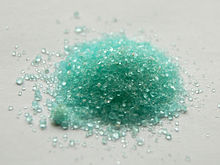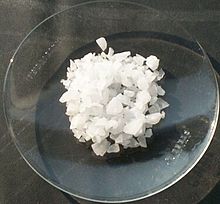Vitriol is the general chemical name encompassing a class of chemical compounds comprising sulfates of certain metals – originally, iron or copper. Those mineral substances were distinguished by their color, such as green vitriol for hydrated iron(II) sulfate and blue vitriol for hydrated copper(II) sulfate.[1]
These materials were found originally as crystals formed by evaporation of groundwater that percolated through sulfide minerals and collected in pools on the floors of old mines. The word vitriol comes from the Latin word vitriolus, meaning "small glass", as those crystals resembled small pieces of colored glass.
Oil of vitriol was an old name for concentrated sulfuric acid, which was historically obtained through the dry distillation (pyrolysis) of vitriols. The name, abbreviated to vitriol, continued to be used for this viscous liquid long after the minerals came to be termed "sulfates". The figurative term vitriolic in the sense of "harshly condemnatory" is derived from the corrosive nature of this substance.
| Vitriol | Chemical | Comment | Formula | Image |
|---|---|---|---|---|
| Black vitriol | Sulfate • Heptahydrate ( Hydrated Sulfate)[A] | [Cu,Mg,Fe,Mn,Co,Ni]SO4·7H2O[B] | ||
| Blue vitriol/Vitriol of Cyprus/Roman vitriol[2] | copper(II) sulfate | pentahydrate | CuSO4·5H2O | 
|
| Green vitriol/Copperas | iron(II) sulfate | heptahydrate | FeSO4·7H2O | 
|
| Oil of vitriol/Spirit of vitriol | sulfuric acid | acid | H2SO4 |  |
| Red vitriol | cobalt(II) sulfate | heptahydrate | CoSO4·7H2O |  |
| Sweet oil of vitriol | diethyl ether | Not a sulfate, but can be synthesized from sulfuric acid and ethanol[3] | CH3-CH2-O-CH2-CH3 | 
|
| Vitriol of argile/Vitriol of clay | aluminium sulfate | alum | Al2(SO4)3 | 
|
| Vitriol of Mars | iron(III) sulfate | Ferric sulfate | Fe2(SO4)3 | 
|
| White vitriol | zinc sulfate | heptahydrate | ZnSO4·7H2O | 
|
| A Many websites state that black vitriol "is a mixture of iron sulfate and iron sulfite", but none give a reference of any sort. The book, Chemistry, Inorganic & Organic, with Experiments, by Bloxam[4] is a published, reliable reference for the composition of black vitriol, and it states on page 513, "The formula of black vitriol may be written [CuMgFeMnCoNi]SO4·7H2O, the six isomorphous metals being interchangeable without altering the general character of the salt." |
| B "Any combination of these elements may be found in black vitriol."[4] |
- ^ "Vitriol" entry in the online Encyclopaedia Britannica. Accessed on 2020-08-28.
- ^ Roman vitriol on Chembk CAS Database
- ^ "Synthesis of Ethers".
- ^ a b Bloxam, Charles Loudon; Bloxam, Arthur G.; Lewis, S. Judd (1913). "Copper, Cu = 63.57". Chemistry, Inorganic & Organic, with Experiments (Tenth ed.). Philadelphia: P. Blakiston's Son & Co. p. 513.
The formula of black vitriol may be written [CuMgFeMnCoNi]SO4·7H2O, the six isomorphous metals being interchangeable without altering the general character of the salt.